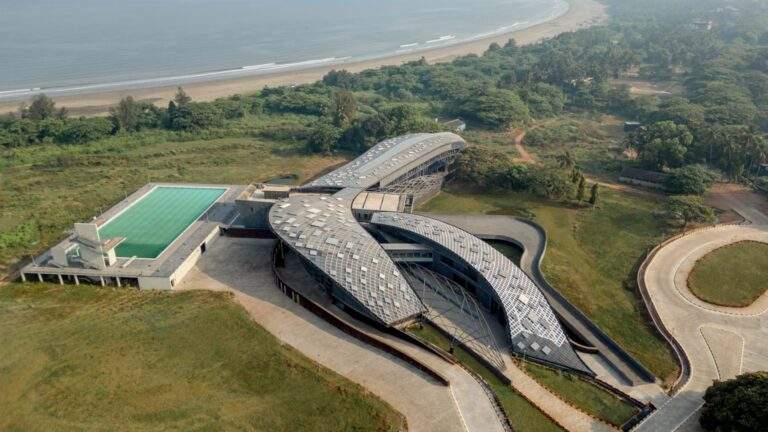Building materials have transformed significantly over the past decades, but with the AI revolution, we are witnessing faster and more complex changes. New technologies are not only reshaping the materials themselves but also revolutionizing how they are manufactured and used, as manufacturers today focus on adopting sustainability as a central approach to address global environmental challenges. Let’s explore what the future of building materials could look like amid these shifts by 2030.
The Revolution of Building Materials with Artificial Intelligence
The building materials industry is expected to undergo a radical transformation by 2030, with AI-driven production and design improvements projected to increase efficiency by 40-50%. Thanks to artificial intelligence, materials are analyzed, and innovative compositions are created to meet environmental standards and the unique engineering requirements of each project. For example, companies like LafargeHolcim are using AI to develop eco-friendly materials, such as low-carbon concrete, aiming to reduce carbon emissions, which currently represent about 8% of global carbon emissions.
Concrete and 3D Printing
Concrete, one of the most widely used building materials, is a major contributor to carbon dioxide emissions. However, with AI, efforts are underway to develop “smart concrete” that reduces its environmental impact, such as incorporating recycled components. Additionally, 3D printing technologies are helping reduce costs and waste, with expectations that 3D printing will be used in about 25% of construction projects by 2030.
Smart and Technology-Integrated Materials
Smart materials, such as smart glass and adaptive insulation, rely on AI to make buildings more energy-efficient. According to a Frost & Sullivan report, the smart building materials market is expected to grow at an annual rate of 15%, reaching USD 74 billion by 2030. These materials allow for greater energy control within buildings, reducing operational costs by up to 30%.
Environmentally Adaptive Materials
Environmentally adaptive materials, such as treated wood and bio-based composites, are becoming more widespread. These materials, developed through AI, offer a sustainable alternative to traditional energy-intensive materials. For instance, companies like Katerra are working on engineered timber-based building materials that are more resilient and effectively adapt to environmental changes.
The Shift Towards Sustainability in Building Materials
As the world increasingly prioritizes sustainability, demand for eco-friendly materials is rising. Studies indicate that the construction industry is responsible for 39% of carbon emissions, with 11% resulting from material manufacturing processes. This drives manufacturers to seek alternatives with less environmental impact, such as renewable energy-produced concrete and buildings constructed with recycled plastics.

The Move Towards a Circular Economy
Many companies are striving towards a circular economy to minimize waste, as construction material waste could be reduced by up to 60% through AI-enabled systems. Companies like Skanska and BASF are focusing on material reuse and recovery, not only to reduce waste but also to provide new resources for construction without depleting natural reserves.
Future Projections for the Building Materials Market by 2030
As 2030 approaches, smart and sustainable building materials are expected to become the norm rather than the exception. Materials like color-changing glass to reduce glare and enhance energy efficiency will become a standard part of conventional construction, helping to reduce energy use by an average of 20% per building.
AI as a Predictor of Material Quality
AI will also play a role in enhancing quality through monitoring systems that predict material degradation. Using sensor data, AI can anticipate when materials need maintenance or replacement, increasing building longevity and reducing costs by up to 30%.
The Role of Manufacturers in Achieving Sustainability
The global market is experiencing significant shifts toward the production of sustainable and smart materials. Many major companies are setting ambitious plans to make their production more sustainable by 2040. For example, CEMEX has announced its goal to achieve zero carbon emissions by 2050, intending to use AI to optimize production processes and reduce the carbon footprint of materials.
Innovation in Manufacturing and a Focus on Natural Materials
In addition to AI, innovation in natural materials like bamboo and flax plays an increasing role. Forecasts suggest that bio-based building materials could meet about 20% of construction needs by 2035, as these materials are renewable and have a significantly lower carbon footprint.
Conclusion: A More Sustainable Future for Construction with AI
The near future seems poised for groundbreaking developments in building materials, with increased reliance on AI as a tool to improve production, efficiency, and environmental footprint reduction. Manufacturers are adopting sustainability more strongly, leading to the development of new and innovative materials that support the circular economy and reduce reliance on depleted natural resources. As 2030 approaches, it is safe to say that the future of construction will largely depend on smart, flexible, and more sustainable materials, making cities more balanced with environmental and sustainability demands.
Images credit: illustrarch and Archova Visuals
Finally, find out more on ArchUp:







